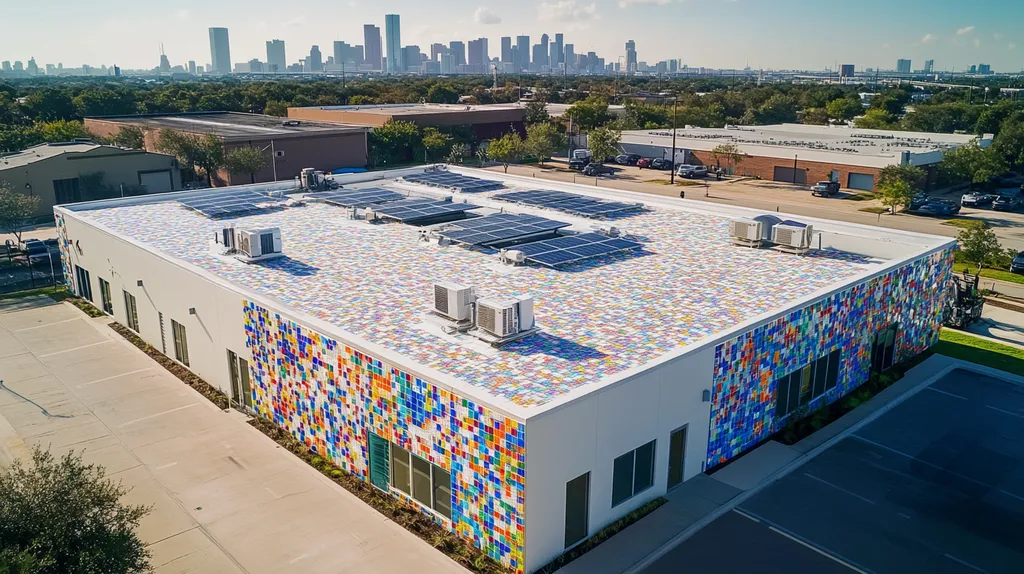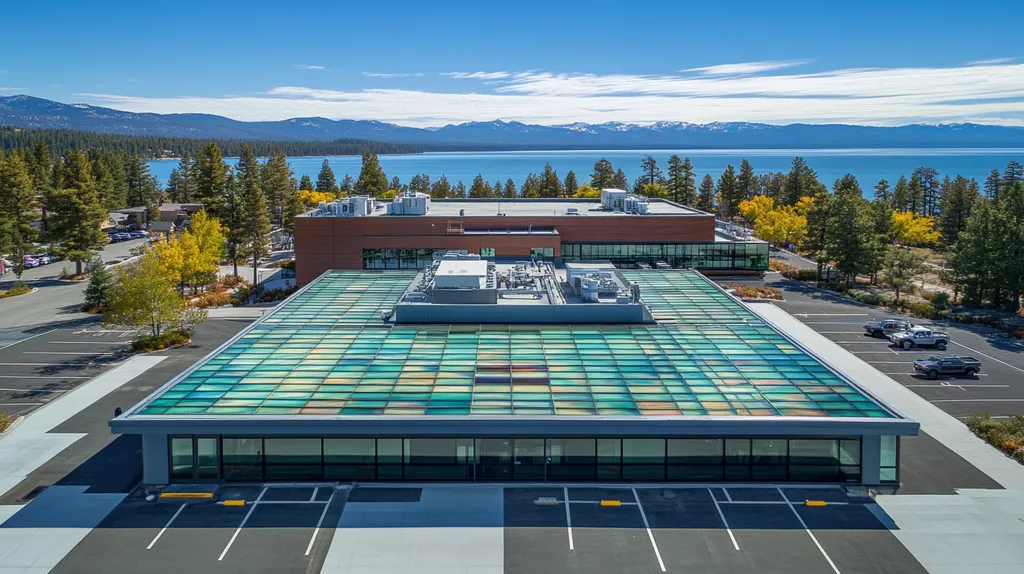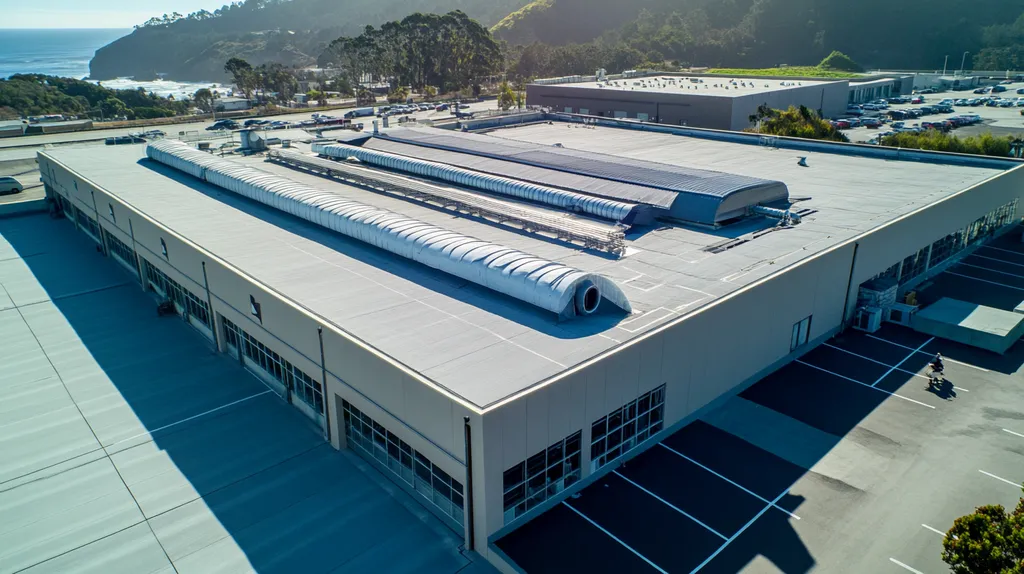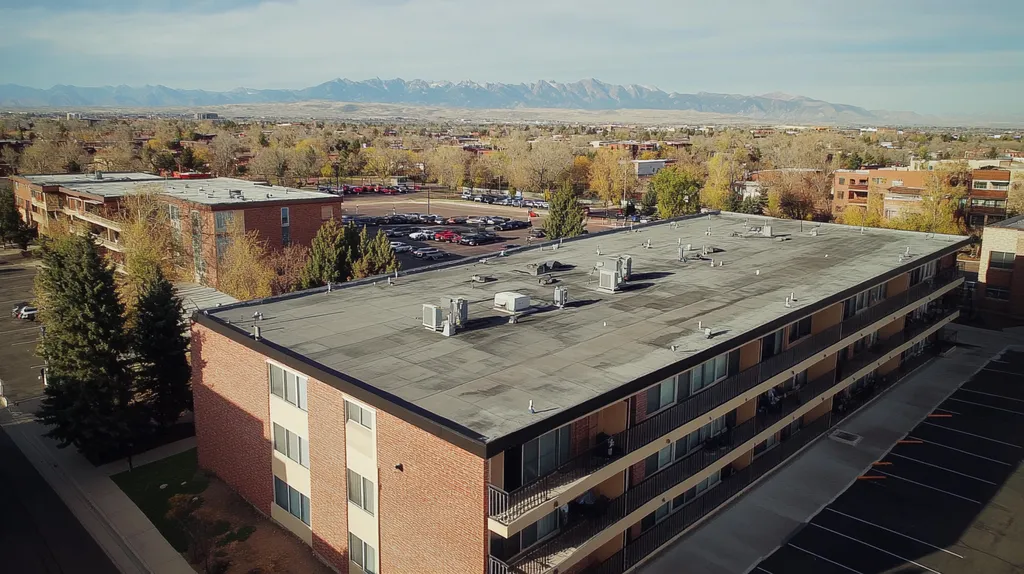Commercial roof inspections during occupancy present unique challenges, with 40% of building envelope failures traced to inadequate roof maintenance during active operations. These oversights cost U.S. businesses over $2.5 billion annually in preventable damage.
Facility managers must balance thorough inspections with minimal disruption to building operations and occupant comfort. This requires strategic planning across performance monitoring, financial considerations, compliance requirements, risk management, and standardized procedures.
The following comprehensive guide provides facility managers with actionable solutions to navigate these challenges while protecting their roofing assets and building operations.
SECTION 1: PERFORMANCE FACTORS
Conducting roof inspections during occupancy is essential for ensuring long-term performance and safety. Alarmingly, 30% of commercial roofs experience premature failure due to overlooked maintenance issues, resulting in significant financial setbacks and operational disruptions. Facility managers must focus on three critical performance factors: roof integrity, drainage efficiency, and material condition. Each of these elements is vital for sustaining a robust and effective roofing system while the building remains occupied.
Roof Integrity and Structural Soundness
The integrity of a commercial roof heavily influences both safety and functionality within a building. Routine inspections should identify visible damage such as cracks, blisters, and punctures—warning signs of potential structural issues that can undermine the entire roofing system.
Facility managers must assess whether the roof can withstand environmental challenges like severe winds and heavy snow loads. Ensuring that support structures are robust is crucial in preventing costly collapses and water leakage. By proactively addressing any vulnerabilities, facility managers can significantly extend the roof’s lifespan.
On top of that, rooftop equipment—such as HVAC units and solar panels—can stress the roofing system. Regular examinations of these areas are essential to protect the roof’s integrity and functionality.
Key Action Items
Drainage and Water Management
Effective drainage is critical for a commercial roof’s longevity. Insufficient drainage can cause water to collect, eventually damaging the structure and promoting mold growth. Facility managers should prioritize unclogging gutters, downspouts, and roof drains as a preventive measure against these risks.
Regular inspections of the drainage system are necessary to ensure that it operates efficiently. This includes checking for blockages, sediment buildup, and verifying that water flows easily off the roof surface. Implementing consistent cleaning routines can prolong the life of roofing materials.
The roof’s slope and design also require careful assessment during inspections. A roof that fails to direct water can suffer from accelerated wear and earlier-than-expected failure. Identifying drainage patterns during inspections is key to preventing potential issues.
Key Action Items
Material Condition and Durability
The condition of roofing materials is a major factor that influences performance and longevity. Over time, exposure to UV rays, moisture, and temperature fluctuations can weaken these materials. Facility managers are encouraged to conduct regular assessments of material condition to catch small problems before they grow larger.
It’s important to inspect membranes, coatings, and flashing to spot early signs of wear and tear. Failing to address these components can lead to leaks that not only threaten interior spaces but also compromise air quality. Regular inspections help identify deterioration at an early stage.
Choosing high-quality, durable materials at installation is crucial for long-term success, but ongoing inspections are still necessary to ensure they can withstand environmental challenges.
Key Action Items
SECTION 2: FINANCIAL CONSIDERATIONS
Understanding the financial impact of roof inspections during occupancy is essential for facility managers. Delayed attention to roofing issues can lead to costly repairs that may strain budgets and disrupt operations. For instance, what begins as a small leak can evolve into extensive water damage if left unchecked, resulting in unplanned expenses and business interruptions. Facility managers must evaluate repair and maintenance costs, warranty coverage, and future budgeting needs for potential roof replacements to secure their organization’s financial health.
Cost of Repairs and Maintenance
Regular roof inspections can uncover minor issues before they balloon into major repair expenses. For instance, catching a small crack or a weak seam early can save thousands in potential water damage. Although routine maintenance—like cleaning gutters and clearing flashings—adds some immediate costs, it significantly helps in preventing larger financial burdens down the line.
Additionally, maintenance contracts can help distribute costs over time, making budgeting smoother. Many companies overlook these ongoing costs, leaving them vulnerable to unexpected repair bills that disrupt financial planning. By investing in preventative measures, facility managers can foster substantial savings and extend the roof’s lifespan.
Key Action Items
Warranty and Insurance Implications
Neglecting routine inspections and maintenance can void a roof’s warranty. Many warranties stipulate that regular service and thorough documentation are essential for maintaining coverage. Facility managers need to ensure compliance to avoid losing warranty protection. If a significant leak arises and a claim is denied due to lack of maintenance records, the financial consequences can be severe.
Moreover, the state of the roof directly influences insurance premiums. Insurers often assess a roof’s maintenance history when determining coverage rates. Regular inspections and keeping detailed records can help sustain lower premiums, resulting in considerable savings over time.
Key Action Items
Budgeting for Roof Replacement
Planning for eventual roof replacement is a vital task for any facility manager. Most roofs have a lifespan of 20 to 25 years, and proactive budgeting can turn what could be a crisis into a planned event. By regularly assessing the roof’s condition through inspections, facility managers can create a replacement timeline that aligns with their financial objectives.
Incorporating a contingency fund for unexpected roofing issues is also a smart strategy. This fund enables organizations to handle emergency repairs without dramatically impacting their capital budgets. By prioritizing effective financial planning, facility managers can ensure stability and readiness for when a roof replacement becomes necessary.
Key Action Items
SECTION 3: COMPLIANCE REQUIREMENTS
Facility managers must grasp the crucial compliance requirements surrounding commercial roof inspections. Ignoring these mandates can lead to hefty fines and potentially unsafe conditions. Adhering to local building codes not only sidesteps legal risks but also increases property value and ensures safety for all building occupants. This section outlines the primary compliance areas that facility managers need to navigate effectively.
Local Building Codes and Regulations
Local building codes are vital for ensuring safe and compliant roofing installations. These codes dictate specifications for materials, installation techniques, and maintenance practices. Failing to adhere to these regulations can jeopardize structural integrity, putting occupants at risk. Research shows that buildings following local codes experience 30% fewer roof-related accidents.
To stay compliant, facility managers should regularly consult with local building offices for any updates to the regulations. Many municipalities offer online resources that can simplify the process of understanding requirements. Conducting regular inspections can also help identify compliance gaps, allowing for timely corrective actions.
Additionally, certain roofing systems may require specialized inspections, especially those intended for stormwater management. Being aware of these unique requirements can prevent costly renovations and ensure successful inspection outcomes, fostering a culture of safety within the facility.
Key Action Items
Certificate of Occupancy Standards
The Certificate of Occupancy (CO) is crucial for confirming that a building meets all legal requirements before occupancy. This document verifies that the roofing system complies with local codes and safety standards. Without a valid CO, a facility may face penalties for operating without authorization, which can lead to significant financial liabilities.
Roof inspections are often necessary before a CO can be issued, making it essential for facility managers to keep accurate records of all roofing activities. Engaging qualified inspectors who understand CO requirements can expedite the application process. Additionally, a current CO enhances a facility’s reputation and reliability among tenants and clients.
Ultimately, staying updated on CO compliance underscores a commitment to quality, safety, and property marketability. Regular assessments can also help maintain the necessary standards for obtaining and renewing a CO.
Key Action Items
Manufacturer and Contractor Warranties
Warranties act as critical safeguards for facility managers, mitigating potential expenses related to roofing systems. However, to keep these warranties valid, compliance with specific stipulations is necessary. Many manufacturers require regular professional inspections and documented adherence to installation guidelines. If these standards are ignored, warranty coverage can be voided, exposing the facility to unexpected costs.
It is essential for facility managers to fully understand warranty terms prior to selecting contractors. Knowledge of warranty implications can influence choices regarding roofing materials and best installation practices. Furthermore, many warranties specify maintenance schedules that must be followed to maintain coverage, ensuring continued protection.
Establishing a proactive maintenance approach aligned with warranty conditions can significantly benefit facility managers. Collaborating with contractors experienced in relevant manufacturer specifications can enhance compliance, ultimately contributing to the longevity and performance of roofing systems.
Key Action Items
SECTION 4: RISK MANAGEMENT
Effective risk management is crucial for safeguarding the integrity of commercial roofs, especially while buildings are occupied. A staggering 40% of roofing issues emerge from unnoticed leaks or damage, highlighting the need for proactive inspections. Facility managers must stay vigilant to identify potential risks, manage weather-related challenges, and control the growth of harmful biological agents. This section explores these essential areas to assist facility managers in maintaining sound roofing systems.
Identifying Potential Leaks and Damage
Detecting leaks and damage is essential for maintaining a healthy roofing system. Even small leaks can escalate into significant issues if overlooked. Regular inspections should focus on common leak sources, including seams, flashings, and penetrations.
Facility managers can enhance their inspections through visual assessments combined with moisture detection technology, such as infrared cameras. Early detection is invaluable, potentially saving up to 70% in repair costs by addressing problems before they worsen. Documenting findings from inspections provides a useful reference for planning future maintenance and reinforces the necessity of timely follow-up actions.
Proper drainage is another critical factor in leak prevention. Clogged gutters or drains can lead to water pooling, significantly heightening the risk of leaks. Facility managers should routinely check these areas to ensure optimal roof performance.
Key Action Items
Mitigating Weather-Related Risks
Weather-related risks can pose severe challenges for commercial roofing systems. Heavy rains, high winds, and extreme temperatures contribute significantly to roof deterioration. Thus, evaluating the roof’s structural integrity before severe weather events is vital.
Facility managers should remain informed about local climate conditions and their impacts on roofing materials. For instance, roofs in hail-prone areas might require added protective layers. Proactive maintenance before storm seasons can greatly mitigate risks associated with severe weather.
Investing in roofing systems built to withstand local weather challenges, such as high-wind-rated membranes, can prolong roof life. Utilizing weather forecasting tools also aids in planning maintenance and inspections, providing opportunities to address potential vulnerabilities before inclement weather strikes.
Key Action Items
Addressing Biological Growth and Debris
Biological growth, including mold and algae, alongside debris accumulation, can significantly threaten the integrity of commercial roofs. This growth not only deteriorates roofing materials but also poses health risks for building occupants. Regular inspections must aim to detect signs of biological growth, particularly in shaded areas where moisture lingers.
Maintaining a clean roof is essential to prevent the buildup of debris. Facility managers should implement a routine schedule for debris removal to avoid moisture retention and subsequent growth. Leaves and branches can trap moisture, creating an environment conducive to mold.
Applying biocide treatments can also effectively manage existing biological threats, using environmentally safe products to safeguard roofing materials. Further, investing in reflective coatings reduces algae growth by reflecting UV rays, which keeps roofs cooler and less susceptible to microbial development.
Key Action Items
SECTION 5: OPERATIONAL PROCEDURES
Conducting regular roof inspections during occupancy is not just a necessary task—it’s pivotal for ensuring the long-term safety and durability of commercial buildings. Overlooking this critical responsibility can lead to damaging leaks and significant safety hazards. For instance, an unmonitored roof may develop issues that adversely affect not only the roofing system itself but also the interior spaces, resulting in costly repairs and operational disruptions. This section outlines essential operational procedures, including effective scheduling of inspections, thorough examination of roof components, and meticulous documentation of findings.
Scheduling and Conducting Inspections
Proper scheduling of roof inspections is key to preventing unexpected problems that might disrupt daily operations. Facility managers should arrange inspections at least twice per year, ideally in spring and fall, to coincide with weather changes. This proactive practice allows for early identification of potential issues before they escalate.
It’s crucial to consider occupancy schedules when planning inspections. Timing these assessments during low-traffic periods minimizes disruption to tenants and staff. Clearly communicating the inspection schedule to building occupants fosters cooperation and helps manage expectations effectively.
Leveraging the expertise of professional roofing contractors during inspections enhances the assessment quality. Experienced inspectors can spot common issues like ponding water or damaged flashings that might be missed otherwise. Additionally, setting calendar reminders for inspections can help facility managers maintain their maintenance routines and ensure compliance with established protocols.
Key Action Items
Inspecting Roof Components and Systems
A detailed inspection of roof components is critical for assessing the overall health of the roofing system. This involves examining various elements including the membrane, flashings, and drainage systems, along with any rooftop units that may exert additional stress.
During inspections, be on the lookout for visible damage or wear, such as cracked membranes or blocked drainage areas. These conditions can lead to ponding water and leaks if not addressed promptly. The integrity of rooftop equipment also deserves attention; unchecked installations can compromise the roof’s structure over time.
It’s essential to focus on the areas surrounding penetrations like vents and skylights, which are commonly weak spots. Regularly checking caulking and seals helps prevent water entry and promotes the longevity of the roof system.
Key Action Items
Documenting and Reporting Findings
Meticulous documentation of inspection findings is essential for effective roof management. Generating a detailed report after each inspection provides a valuable historical record of the roof’s condition, helping to track changes and plan future maintenance needs.
A comprehensive report should include photographs of any issues, descriptions of observed conditions, and actionable recommendations for repairs. This level of transparency facilitates informed decision-making regarding necessary actions.
Sharing these findings with key stakeholders, including property owners and maintenance teams, ensures everyone is aligned on the roof’s status. This regular communication aids in planning budgets for scheduled repairs and maintenance. Additionally, maintaining a historical log of inspections and repairs can streamline future inspections while enhancing accountability.
Key Action Items
SECTION 5: OPERATIONAL PROCEDURES
Regular roof inspections during occupancy are essential for maintaining the longevity and safety of commercial buildings. Ignoring this critical task can lead to expensive repairs and potential safety hazards, such as leaks damaging both the roofing system and interior spaces. This section highlights key operational procedures, including the scheduling of inspections, examination of roof components, and thorough documentation of findings.
Scheduling and Conducting Inspections
Effective scheduling of roof inspections is vital to mitigating unexpected issues that could disrupt operations. Facility managers should aim to conduct inspections at least twice a year, ideally during the spring and fall months, to align with weather transitions. This proactive strategy enables the early detection of potential problems before they escalate into serious concerns.
It’s crucial to take occupancy schedules into account when planning inspections. Scheduling these assessments during low-traffic times minimizes disruptions for tenants and staff. Clear communication about inspection timelines fosters cooperation among occupants and helps manage expectations.
Engaging professional roofing contractors for these inspections adds significant value. Experienced inspectors can identify common issues, such as ponding water and damaged flashing, which may go unnoticed by untrained personnel. Setting calendar reminders for inspections ensures facility managers remain compliant with established maintenance routines.
Key Action Items
Inspecting Roof Components and Systems
Conducting detailed inspections of roof components is essential for assessing the overall health of the roofing system. This involves checking the membrane, flashings, drainage systems, and rooftop units, as each component has unique vulnerabilities that require attention.
During these inspections, facility managers should keep an eye out for visible signs of damage or wear. For instance, cracked or blistered membranes may indicate deterioration due to age or weather exposure. Ensuring drainage areas are free from debris is crucial to preventing water pooling, which can lead to leaks.
The condition of rooftop equipment must also be considered, as units such as HVAC installations can impact the roof’s structural integrity if not properly maintained. Special attention should be given to penetration areas like vents and skylights, as these are common weak points needing regular checks of caulking and sealing.
Key Action Items
Documenting and Reporting Findings
Accurate documentation of inspection findings is critical for effective roof management. Creating detailed reports after each inspection provides a historical record of the roof’s condition, enabling facility managers to track changes and plan future maintenance effectively.
Reports should include photographs of problem areas, well-documented descriptions, and actionable recommendations for repairs. This transparency allows for informed decision-making regarding necessary actions and priorities.
Sharing inspection reports with property owners and maintenance teams ensures that all parties are informed and aligned regarding the roof’s status. This regular communication is crucial for budgeting repairs and maintaining the roof effectively. Additionally, keeping a historical log of inspections and repairs can help streamline future efforts while enhancing accountability.
Key Action Items
Moving Forward
Commercial roof inspections during occupancy represent a critical intersection of safety, compliance, and asset protection, with industry data showing that proactive inspections can prevent up to 85% of premature roof failures.
By implementing comprehensive inspection protocols outlined in this guide, facility managers can save an average of $2.50 per square foot annually in repair and replacement costs.
The stakes are clear: neglecting regular inspections during occupancy leads to accelerated deterioration, compromised structural integrity, and significant financial exposure.
As building technologies advance and compliance requirements evolve, maintaining rigorous inspection schedules becomes increasingly vital for protecting both property investments and occupant safety.
Success lies in treating roof inspections not as periodic tasks, but as integral components of a facility’s operational framework.
FREQUENTLY ASKED QUESTIONS
Q. Why is roof integrity important for a commercial roof?
A. The integrity of a commercial roof is crucial for safety and functionality. Routine inspections help identify visible damages like cracks and punctures that could lead to major structural issues. Addressing these vulnerabilities promptly extends the lifespan of your roof and protects the building’s interior.
Q. How can neglecting a commercial roof inspection affect finances?
A. Delaying roof inspections can lead to small leaks escalating into extensive water damage, resulting in costly repairs. While maintenance contracts can distribute costs over time, failing to invest in preventative measures can lead to unexpected financial burdens that disrupt your budget.
Q. What are the compliance requirements for a commercial roof?
A. Compliance for commercial roofs involves adhering to local building codes and regulations. These codes provide specifications for materials and maintenance practices. Regular compliance checks help mitigate legal risks and ensure safety for building occupants while preserving property value.
Q. How do I identify potential risks during roof inspections?
A. Identifying risks involves regular inspections focused on common leak sources, such as seams and flashings. Utilizing moisture detection technology can enhance your assessments. By documenting findings, facility managers can prioritize repairs, significantly reducing the chance of developing costly issues.
Q. What operational procedures are essential for roof inspections?
A. Scheduling inspections at least twice a year is crucial for early issue detection. Inspections should coincide with low-occupancy periods to reduce disruption. Engaging professional roofers adds expertise, while thorough documentation of findings ensures effective long-term roof management and maintenance planning.
Q. How does weather affect commercial roof integrity?
A. Weather conditions like heavy rains, high winds, and extreme temperatures can contribute to roof deterioration. Facility managers should assess the roof’s integrity before severe weather, implementing preventive maintenance. Using weather forecasting tools supports preemptive strategies to protect roof performance during storms.
Q. What are some advanced materials for industrial roofs?
A. Advanced materials for industrial roofs include TPO and PVC membranes, known for durability and energy efficiency. Additionally, spray foam roofing provides excellent insulation and can form a seamless barrier against leaks. Selecting high-quality materials during installation enhances performance and longevity, supporting sound roof management.











